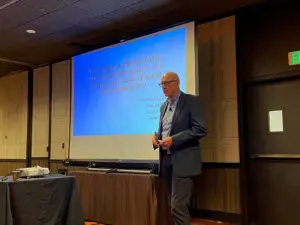When governments approve a mining lease, the expectation is that the land will be restored to its pre-mining state, that ecosystems can be restored, and that agricultural lands can be reintroduced into production. However, globally, the examples of complex mines returning to a safe, stable, non-polluting state, capable of sustaining a post-mining land use, are modest, to say the least. Yet this expectation, or variations on it, persist around the world.
At the same time, global demand for natural resources, especially those facilitating the transition to a low-carbon economy, continues to increase.
According to James Purtill, Queensland Mine Rehabilitation Commissioner, CRC TiME Partner and PhD Scholarship recipient, “it’s time to explore new paradigms of mined land stewardship – models in which governments and miners take on new responsibilities for the impacts from natural resource extraction”.
He continued, “A new paradigm would not see regulators and miners so much ‘meet in the middle’ as move respectively towards management regimes that protect our limited natural resources, the environment, and the social-ecological systems in which mines operate.”
James presented his related paper, “Re-thinking our model of mine rehabilitation and closure – is it time for a new model of mined lands stewardship?”, at this year’s Mine Closure 2023 conference in Reno, Nevada; an event that focuses on the pressing issues facing the global mine closure community.
His paper investigates the industry’s track record of successful relinquishment of mines under contemporary environmental standards, and highlights the iterative nature of mining.
“The mines that are extracting critical minerals have become essential for our transition to a lower carbon economy,” James said. “As such, I argue that we should be mindful of preserving responsible access to those minerals as well as ensuring a safe, stable and non-polluting environment.”
 At the conference, James outlined the external pressures exerted on the industry – namely, sentiment and capital flowing from fossil commodities while, simultaneously, the opposite is occurring for critical minerals. “Policy makers, miners, and researchers must adapt to our new “two-speed” industry,” he said.
At the conference, James outlined the external pressures exerted on the industry – namely, sentiment and capital flowing from fossil commodities while, simultaneously, the opposite is occurring for critical minerals. “Policy makers, miners, and researchers must adapt to our new “two-speed” industry,” he said.
He also highlighted some industry responses to these pressures, including asset disposals, long-term care and maintenance, and emerging institutional responses such as demergers.
As someone responsible for publishing best practice advice on mine rehabilitation, and providing advice to the Minister for Environment, James believes there is a notable gap in mine closure between policy and regulatory settings, and actual on-the-ground performance.
He stated, “The gap between the capability and performance of the industry, and the expectations of the regulator, manifests as, firstly, a growth of rehabilitation liability, as land disturbance outpaces progressive rehabilitation; secondly, few mines successfully rehabilitate to a safe, stable, non-polluting landform able to sustain a post-mining land use; thirdly, larger mining entities are exiting fossil-fuel-based commodities as decarbonisation pressures mount; and fourthly, mines are entering long-term care and maintenance.”
He concluded that a new paradigm of mined land stewardship could re-caste the rehabilitation task from an expectation that ‘the eggs can be unbroken’, to a model of responsible stewardship of our resources endowment.
Download the full paper here.
James Purtill would like to thank CRC TiME for making his participation in Mine Closure 2023 possible through his PhD Scholarship.
“The QMRC sees enormous opportunity in partnering with the CRC TiME as we work towards a common goal of supporting effective rehabilitation of mined land. The challenges facing the mining industry at present involve social, economic, and scientific components and won’t be solved by individuals working alone or within disciplinary silos. QMRC is keen to collaborate with the CRC TiME to address these complex interdisciplinary challenges in mine rehabilitation and see delivery of beneficial post-mining outcomes for mining regions in Queensland.”
(https://crctime.com.au/blog/three-new-partners-join-crc-time/)


